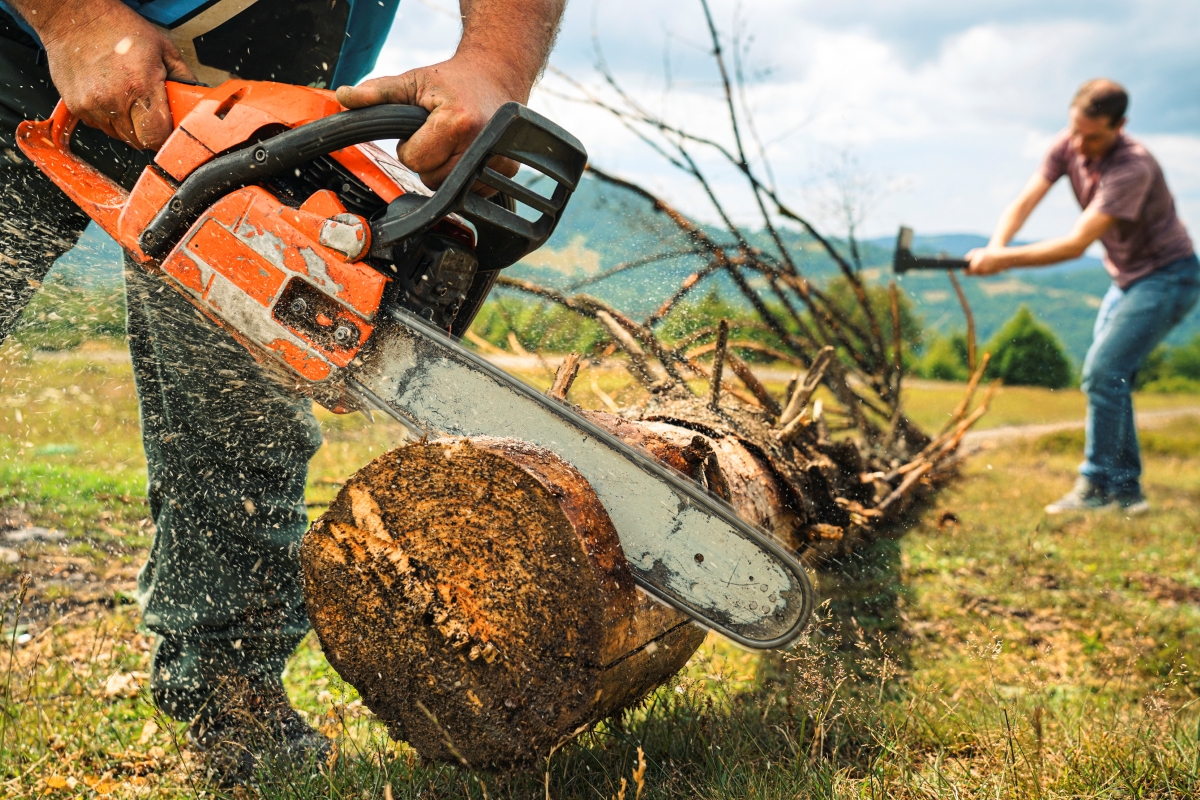

We may earn revenue from the products available on this page and participate in affiliate programs. Learn More ›
The chainsaw, a portable power tool that cuts wood via a fast-moving chain that rotates around a guide bar, can make short work of pruning, felling, limbing, and bucking trees. It also ranks as the most dangerous power tool available without a license.
While it’s designed to cut with either the top or bottom of the blade, just about anything that comes in contact with the top half of the end tip of the blade (known as the kickback zone) can change the cutting momentum and cause the saw to slam back against you. Kickback can lead to catastrophic injury, so users must take extra precautions and always follow proper form for how to properly use a chainsaw in order to avoid disaster.
Before you pick up any chainsaw, whether it’s high power or low, gas or electric, take the risks very seriously.
Safety Tips for Chainsaw Users
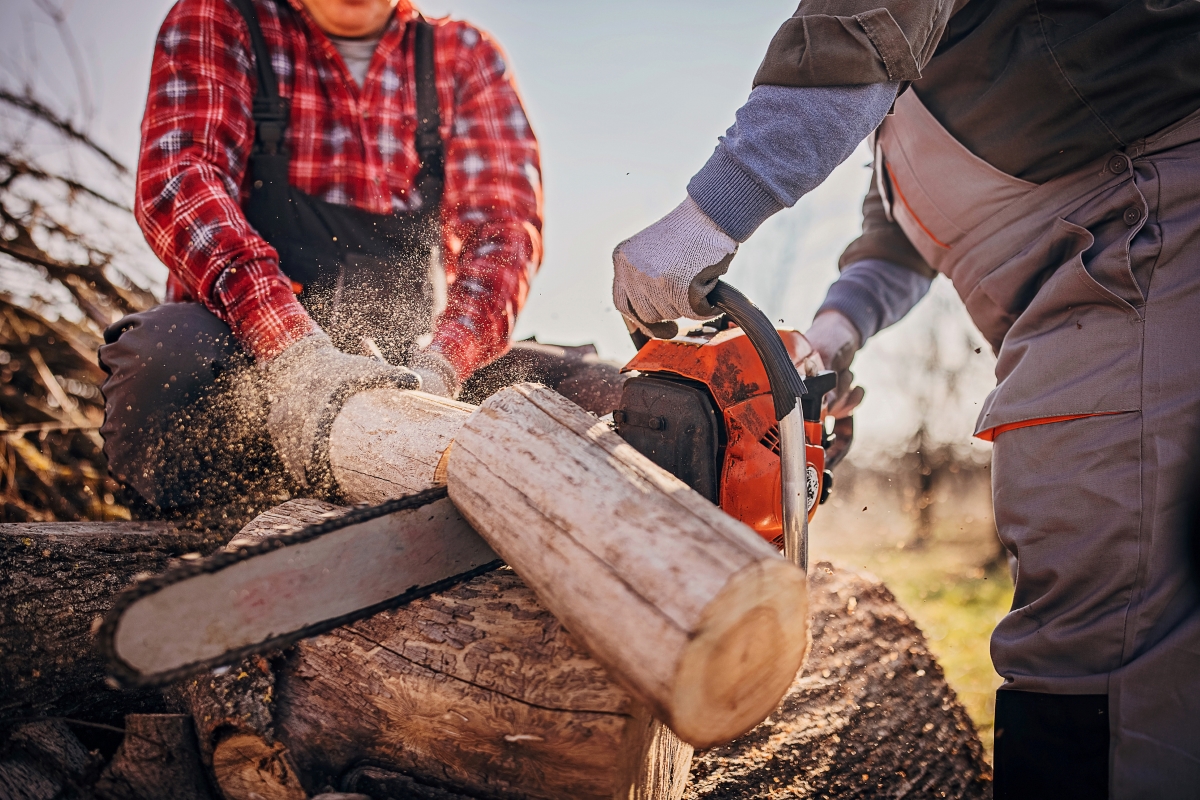
You can operate a chainsaw more safely and minimize the chances of kickback by keeping the chain sharp and tensioned, and by following the steadfast rule of always cutting below shoulder height.
As well, today’s lower-powered chainsaws (including electric chainsaws), which were developed not for pro lumberjacks, but for chainsaw DIYers who want to get their own firewood and keep their property pruned, rely on a low-kickback chain that grabs less fiber as it rounds the kickback zone, minimizing the likelihood of kickback.
It’s a good idea to familiarize yourself with these safety considerations before operating a chainsaw, then follow our practical tips for safe, effective cutting.
Enlist a buddy.
Whether you’re learning how to use a chainsaw for the first time or on a routine job, never operate this power tool alone. When something goes wrong, it happens fast. Having a friend nearby can save your life. If you’re working in the woods, set a traffic safety flag by your car. Make sure someone knows where you are and when you intend to return. Have a complete first aid kit on hand with at least one blood-clotting bandage.
Use protective equipment.
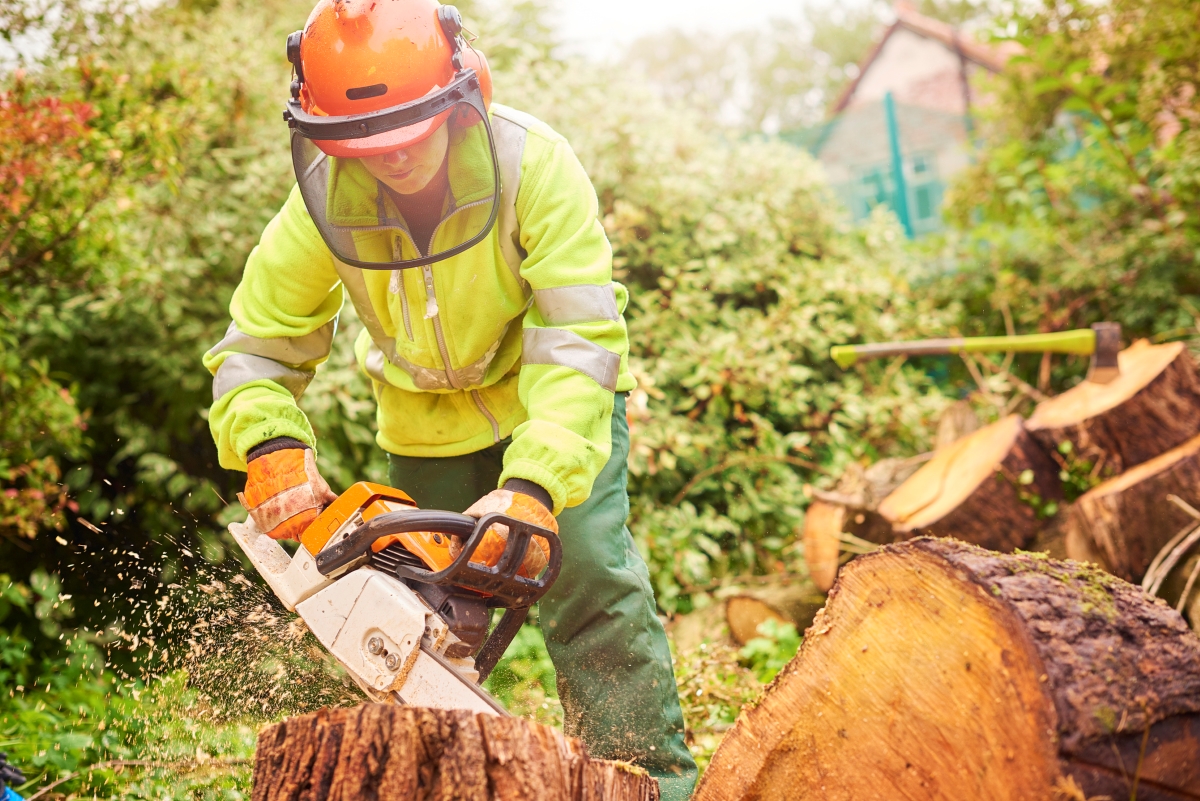
Wear all necessary personal protective equipment, including chaps, a chainsaw helmet with face guard, gloves, and either steel-toed or logging boots. Never wear loose clothing, as it can get caught in the teeth of the saw.
Assume the correct position for holding the saw.
Find a comfortable stance, and keep both feet firmly planted as you work. Hold the chainsaw with two hands and at an angle or a little to one side rather than directly in front of you, in case of kickback.
Think before you cut.
Never operate a chainsaw on a ladder, and never cut limbs that are higher than your shoulder. (If you’re looking to cut something higher, consider an altogether different tool: a manual rope saw, often called a pocket chainsaw.) To remove lower branches and buttress roots prior to felling a tree, slice downward and use the pulling chain—that’s the portion of the chain as it wraps the bar’s bottom. If the tree is on an incline, always work uphill from it.
Also, be aware of the location of all power lines, and never fell a tree where there are utility lines, vehicles, buildings, or especially people within two-and-a-half tree lengths.
Use the correct chainsaw for the job.
Use the right-size chainsaw for the job. If you’re renting a chainsaw, discuss the scope of the job with the staff to learn what size motor they recommend, as blade size is relative to engine horsepower. Generally, the blade should be 2 inches longer than the wood it’s cutting. Light-duty cutting of firewood and such can be accomplished by a 14-inch blade, and 16- to 20-inch blades are appropriate for medium-duty cutting. The longer a blade, the harder it is to control, so novices should stick to blades less than 20 inches in length.
Tools & Materials
Bobvila.com may earn a commission from purchases made through these links.
How to Use a Chainsaw Safely
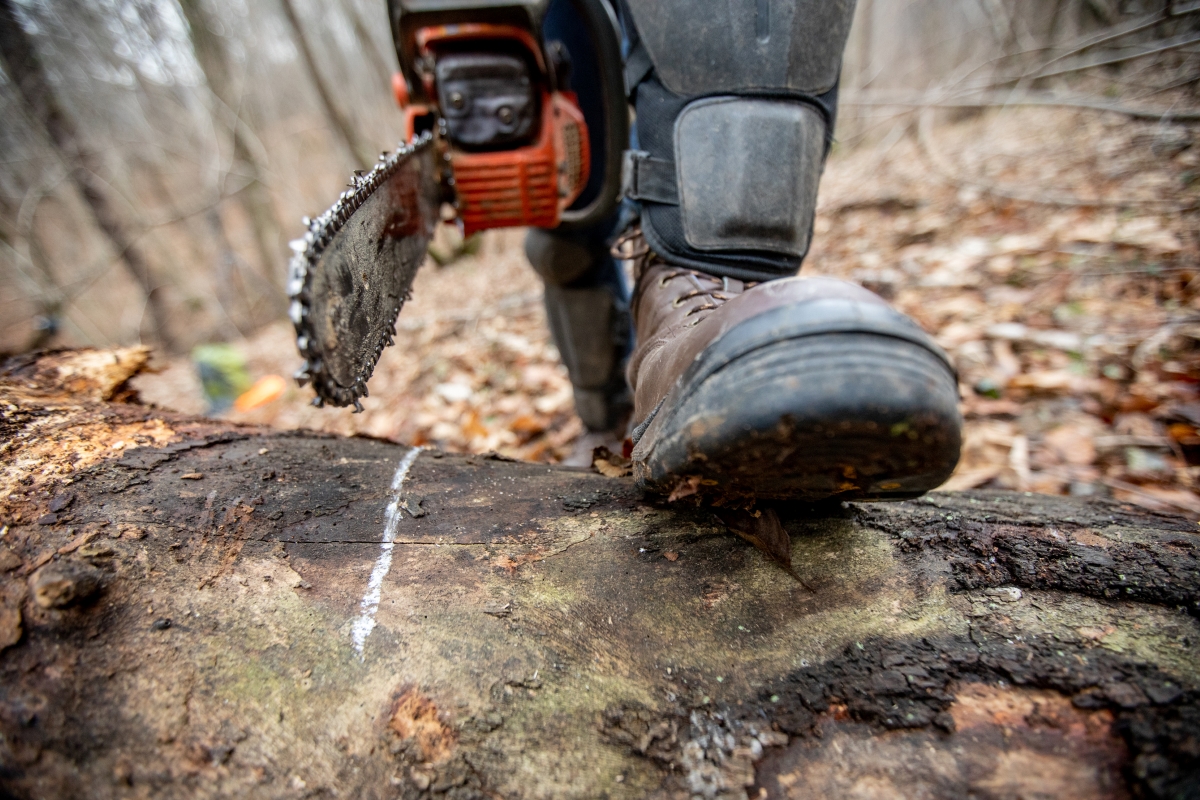
Step 1: Scan your work area.
Familiarize yourself with your work area. Be aware of your “escape routes”—places you can safely move to once the tree begins to fall. Your tree could fall in an unexpected direction, so it’s best to be prepared for any possible scenario. Chainsaws are called “widow-makers” for good reason—they can be hazardous to operate. Be sure to have a plan and understand the terrain you’re working on.
Step 2: Prepare yourself and the saw.
Don your protective gear, from head to toe. Check your saw to ensure that the chain has good tension. If you can tug the chain up from the guide bar and disengage the chain links from the guide or the “nose,” it’s too loose. You’ll need to tighten the tension to prevent injury.
Check your machine’s maintenance guide for instructions on tightening the chain. Most of the time, you’ll use the “scrench” (screwdriver/wrench) that comes with the machine. A properly tightened chainsaw chain should give slightly when pulled but should not become disengaged from the guide.
Step 3: Check the gas and oil levels.
If you have a gas machine, check the gas levels and fill the tank before you start. With a two-cycle engine, the gas and oil will likely require mixing in the tank. Buy two-stroke oil and add it to the tank at the manufacturer’s recommended ratio (usually a ratio of 50:1, or about 2.6 ounces of oil to a gallon of gas). Fill the chain lube reservoir with chain oil.
Step 4: Engage the chain brake.
Set your chainsaw flat on the ground, with the bottom down. Push the chain brake forward until it locks. The chain brake, which is usually a separate lever located between the top handle on the chainsaw and the blade, prevents the chain from spinning until you release the brake and apply the throttle.
Pro Tip
It should go without saying, but we’ll say it anyway: You should always be stone-cold sober when operating a chainsaw.
Step 5: Choke and prime the saw.
If you’re using a gas-powered saw and it has a choke, turn it on. If there’s a primer button, push it four to six times to pull gas into the carburetor, then press the decompression valve. If your chainsaw is electric, all you need to do is depress the safety switch and flip the power switch on.
Step 6: Secure the saw and pull the starter handle.
Those with electric chainsaws can move on to Step 7. For those with gas chainsaws, put your right foot through the back handle and put your weight down on the handle to secure the saw. Use your left hand to hold the front handle firmly in place. With your right hand, pull the starter rope out sharply to its full length. It will usually take four or five pulls to start the engine. If the engine is “firing” but not engaging, adjust the choke by pulling it out halfway.
Step 7: Brace yourself to make a cut.
Even after the engine has started, the chain won’t be turning. You’ll need to press the trigger or throttle to get the chain moving. But first, position yourself properly with feet planted firmly and a strong grip on the saw. Always cut with the saw off to the side or angled away from you to minimize injury in the event of kickback.

Tried-and-True Advice
“Use a log stand or sawbuck for stability.
If you’re cutting logs for firewood, a sawbuck or log stand can make the process safer and more efficient. It keeps the log off the ground, preventing the chain from accidentally hitting dirt or rocks, which can quickly dull it. I learned this the hard way when I ruined a nearly new chain by cutting too close to the ground.”
—Paul Rankin, Contributing Writer and Editor
Step 8: Make the cut.
When you’re ready to cut, release the chain brake and fully engage the throttle. Lay the saw where you want to cut. Don’t apply pressure—the momentum of the chain and blade will draw the wood in. Never, ever force it. If you’re using a corded electric saw, always make sure you’re aware of the cord, and don’t let it get in your way.
Step 9: Finish the cut.
Maintain a strong, steady grip and keep the throttle fully engaged for the duration of the cut. Release the throttle only after you have cut through or removed the blade from the cut (if you’re making carved-in cuts for tree felling).
Step 10: Turn off the saw.
To power off the saw, simply switch it to “off.” Let the saw cool down before storing it.
If you’re using a gas saw, now’s the time to decide what you’ll do with the fuel left in the tank before you stow the saw. If you’re planning on using the chainsaw again in the near future, it’s fine to leave leftover fuel in the tank for up to 4 weeks. However, if you leave the saw for a longer period of time you will need to drain the fuel or add a fuel stabilizer, otherwise the ethanol in the fuel could clog or gum up the works (meaning you’ll need to disassemble and thoroughly clean the carburetor before your next use).
To empty the tank, take the chainsaw to a well-ventilated place and drain any remaining fuel into a plastic container. You can often dispose of leftover fuel at a local automotive shop, but never pour this flammable substance into the soil, storm drain, or garbage, as these practices are dangerous and illegal. Once the fuel has been drained, fire up the engine once more (as in Steps 4 and 5) and run it until it dies, just to use up the last of the fuel in the carburetor.
No matter whether your chainsaw is gas or electric, store it in a case or with a bar cover to keep it safely stowed away and to prevent dust and debris from settling on the chain.
Tips for Chainsaw Maintenance
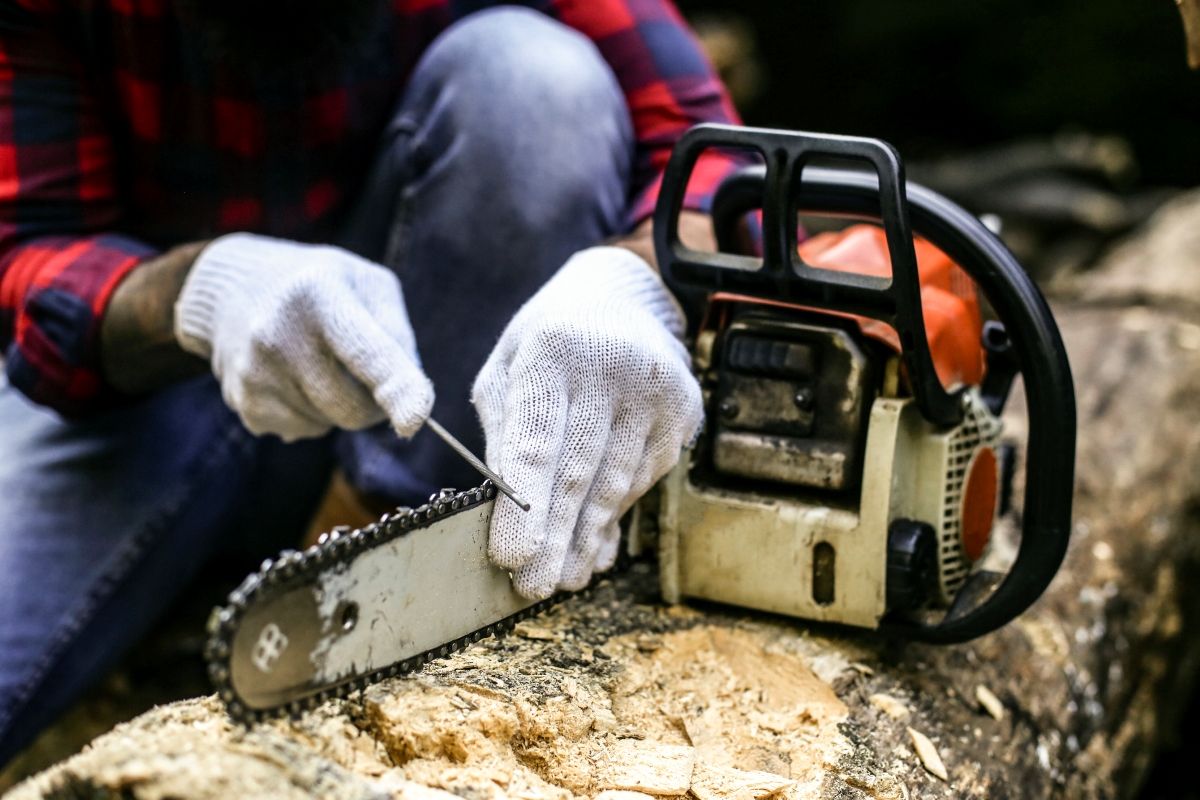
To maintain a chainsaw and keep it running well, refer to your machine’s instruction manual for specific advice about your make and model. Generally speaking, these are best practices to follow:
- Check the chain’s tension around the guide bar every time you use the saw. If necessary, refer to the maintenance guide that came with your chainsaw to adjust the tension of the chain.
- Sharpening may be required every three to four tanks of gas, but exactly how often will depend on the kind of wood you’re cutting, so pay close attention to changes in performance to help you determine when to sharpen the chainsaw.
- Clean the chain and guide bar to prevent premature wear. Dismantle the chain and the guide bar, then use a file gauge and degreaser solvent to remove oil and dirt.
- Check the air filter regularly and remove any light debris with a can of compressed air. If the air filter is too dirty, replace it before using the chainsaw.
- Properly mix the fuel according to the manufacturer’s directions. For most two-stroke chainsaws the mix is typically 50 parts gasoline to one part engine oil, but some products may require a different ratio, so it’s necessary to refer to the owner’s manual provided by the manufacturer.
FAQs
There are many things that you should not do with a chainsaw, such as cutting in the kickback zone, cutting above your shoulder height, or operating a chainsaw under the influence of drugs or alcohol. Consider these other safety precautions when operating a chainsaw:
• Avoid walking around with a chainsaw while the chain is moving.
• Never leave a chainsaw running unattended.
• Do not attempt to cut anything other than wood.
• Don’t cut two or more branches at a time.
• You should not operate a chainsaw if you are fatigued.
• Keep oil and fuels off the handles.
As far as safety precautions and the act of cutting goes, electric chainsaws should be used in the same manner as their gas-powered counterparts. The main difference is starting the tool. To start an electric chainsaw, you simply plug it in or snap in a battery; then follow the individual tool’s manual for turning on the motor.
Learning how to use a chainsaw properly is necessary to stay safe while you work. The safest and most controlled way to use a chainsaw is to cut wood down from the top to the bottom.
The position of your hands is important when learning how to use a chainsaw safely. The chainsaw has a chain brake that may not protect the user if they are holding it the wrong way. Chainsaws are right-handed, so you should hold it with two hands, with the left hand on the top and the right hand on the rear. Using a chainsaw left handed can lead to injury if the chainsaw kicks back, pulling the chain back into your body.
If the chainsaw is not cutting straight it may be due to cutting technique or a problem with the chain and guide bar. When cutting, you should avoid pushing the chainsaw sideways and complete the entire cut in a straight line.
If your technique is good, then you may need to sharpen the teeth on the chain for a more uniform cut, check and adjust the chain tension, and consider flipping over the guide bar periodically to even out the wear.
The easiest type of chainsaw to start is an electric chainsaw. These tools start up with the push of a button, so you don’t need to worry about yanking on a pull cord to start the engine.
Some DIYers may feel comfortable sharpening the chainsaw on their own. Others might opt to take the tool to a local home improvement store that offers sharpening services. If you’re doing it yourself, follow these steps to sharpen the chainsaw:
1. Use special files based on the size of the chain. Check the owner’s manual to determine the correct file size.
2. Disconnect the power source if you are working with an electric chainsaw to prevent an accidental start, then clamp the saw in a bench vise.
3. Hold the handle of the file in one hand and use the other to guide the file through forward strokes along each tooth. If done correctly, the file should only sharpen on the forward stroke, then pull the file out and reinsert it at the front of the tooth before pushing through again.
4. Start with the master tooth, guiding the file along the tooth, while applying pressure from the inside outwards. Make sure to file at a 90-degree angle to the guide rail and rotate the file regularly to avoid one-sided wear.
5. Repeat this process until all teeth have been sharpened. If necessary, use a filing aid, like a file angle plate, to help maintain the correct angle.
